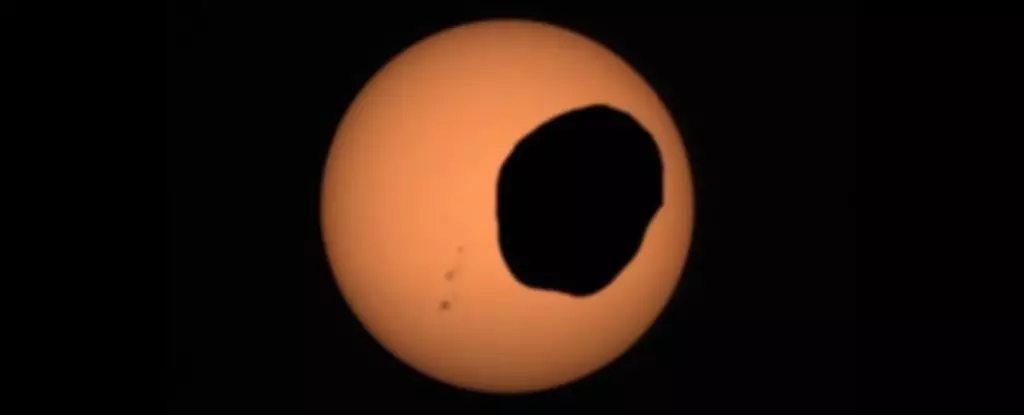Our planet, Earth, is filled with extraordinary phenomena that constantly remind us of its distinctiveness. Surprisingly, these reminders are not limited to far-off locations; they can even occur in our neighboring planet, Mars. Mars, like Earth, experiences eclipses caused by its moons. However, the eclipses on Mars, as observed by NASA rovers Opportunity, Curiosity, and Perseverance, differ significantly from those on Earth.
The Uniqueness of Martian Eclipses
Unlike the prolonged periods of eclipses on Earth, Mars encounters shorter moments when its moons, Phobos and Deimos, cast shadows on its surface. These two Martian moons, Phobos meaning “fear” in Ancient Greek, and Deimos meaning “dread,” orbit Mars every 7.65 and 30.35 hours, respectively. In comparison, Earth’s moon takes approximately 27 days to complete one orbit. Furthermore, Phobos and Deimos are significantly smaller than our Moon, and they possess irregular shapes, resembling little moontatoes instead of the round disk we admire in our night sky.
These Martian events are technically transits rather than eclipses as we perceive them on Earth. When Phobos or Deimos passes between the Sun and observers on the Martian surface, they do not completely block out the Sun’s light like the Moon does here on Earth. Instead, they create an image of the Sun similar to a giant eyeball with a peculiar pupil, following an unseen object from the perspective of the Martian observer. Perseverance has captured a striking example of such a transit in a captivating video.
Scientists have uncovered a fascinating phenomenon during the passing of Phobos’ shadow on Mars. The Mars InSight lander, designed to measure seismic activity, slightly tilts during these events. This inclination is attributed to the slight deformation of Mars’ surface caused by the reduced solar radiation. Even when Phobos is fully engulfed by the Sun’s glare, it can block up to 40 percent of the sunlight, emphasizing its larger silhouette compared to Deimos.
In contrast, Deimos, situated farther from Mars and relatively smaller, obstructs significantly less light. This stark difference further accentuates the extraordinary nature of our planet. On Earth, during a total solar eclipse, the Moon perfectly covers the disk of the Sun, despite being much smaller. This phenomenon is an intriguing coincidence: the Moon is approximately 400 times smaller than the Sun, yet it is about 400 times closer to Earth. This alignment creates the illusion that the Sun and the Moon have a comparable size in our sky.
The sizes of the Sun and the Moon may slightly vary due to the eccentricities of Earth’s and the Moon’s orbits. These variations result in annular eclipses, where the Moon does not fully obscure the Sun, leaving a luminous ring around the Moon’s disk. Remarkably, our species emerged at just the right time to witness these near-perfect eclipses. The Moon originated much closer to Earth and is gradually moving away at a rate of approximately 3.82 centimeters (1.5 inches) per year. Eventually, in around 600 million years, total solar eclipses will no longer occur on Earth.
Studying solar eclipses on Earth provides valuable insights into the Sun and allowed for the critical testing of Einstein’s theory of general relativity over a century ago. In a similar vein, eclipses on Mars offer key opportunities for scientific exploration. By observing the motion of Phobos and its gravitational effect on Mars, scientists can gain a better understanding of the mysterious Martian interior. These observations can also aid in predicting the inevitable fate of Phobos.
Phobos is gradually getting closer to Mars and will eventually succumb to the planet’s gravitational pull, resulting in its disintegration. During this catastrophic event, scientists believe that Mars will temporarily possess a ring composed of the remnants of Phobos. Tracking the movements of both Phobos and Deimos across the Martian sky provides valuable data that contributes to mapping and predicting this awe-inspiring destiny.
The eclipses on Mars present a unique spectacle, distinct from the eclipses experienced on Earth. These Martian transits, caused by the moons Phobos and Deimos, offer extraordinary scientific opportunities to study the Martian interior and predict the future fate of Phobos. While Earth’s eclipses showcase the perfect size match between the Moon and the Sun, Mars provides its own captivating celestial shows. As we explore the wonders of our neighboring planets, we continue to marvel at the diverse and fascinating phenomena dispersed across our cosmos.



Leave a Reply